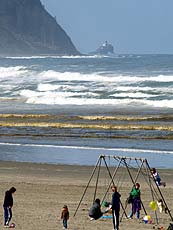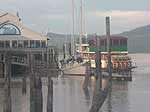 |
Published 04/16/07
NOTE: for a later story on this, see Brown Breakers Mystify Oregon Coast Tourists; Shops Questioned Thick brown patches of foam are freaking out visitors, but it's a good thing
Brown Goo Spotted on Oregon Coast Not Pollution
Story by Tiffany Boothe and Andre' Hagestedt
 |
| Brown diatoms on the water at Seaside (photo: Tiffany Boothe) |
(Oregon Coast) – It’s a question often asked by tourists to the area these days, especially those visitors new to the area. Is it oil? Is it sewage? No, it’s only diatoms: one of the most important food sources in the ocean.
The Oregon coast has lately been the recipient of a large amount of brown goo floating on top of the ocean waves, often washing up on the sand. This is not pollution, but tiny creatures called diatoms which are in such abundance right now they form some massive displays along the coast.
The brown stuff has been seen floating in massive chunks along portions of calmer seas, but often getting tussled around by waves as well. These then drift often onto shore in foamy masses, creating some interesting sights which leave many beachgoers scratching their heads or worrying about where they’re walking.
In Seaside, it’s spotted drifting between the crashing waves along normally very active surf. It’s quite obvious while just standing along the great, long sandy beaches of the north coast. Along the central coast, it’s even more visible and prominent in many spots, as there numerous bays and highpoints which allow viewers to look down and catch sight of the phenomenon. But also these natural structures create spaces of deep, calmer waters where the waves don’t break up the banks of brown stuff. It makes their presence even more pronounced and spectacular. Near Depoe Bay, both Boiler Bay and Whale Cove have been excellent vantage points from which to catch the diatom masses lazily drifting along, although the numerous high spots above Newport’s beaches make for great viewing as well.
 |
| Boiler Bay on the central coast: calmer sections of water and high vantage points allow better viewing of the brown stuff |
Diatoms are at the bottom of the food chain of the ocean, but they create much of what you see visually on the beaches of the Oregon coast, or any other coast, for that matter. They are the tiny, microscopic plant-like creatures that are part of the phytoplankton family. They are about 100 micrometers long – or 1000 times the size of a virus. Still, they’re not visible with the naked eye.
In the spring and early summer, diatoms multiply at the rate of one hundred billion to two hundred billion in just 30 days. These “blooms” create such masses of them they appear in the surprising ways and curious formations that tourists have been seeing.
The diatoms eat large amounts of nitrates and phosphates and leave behind carbohydrates, fats, proteins and vitamins. Their bodies also store oil to live on. If you look closely at the bubbles created by phytoplankton you will notice that they look as if they have oil in them, as in the photographs here.
 |
| Brown goo on the waves of Seaside (photo: Boothe) |
Diatoms and other types of phytoplankton are also largely responsible for the regular sea foam you see on the coastline. Those bubbles that hit the beaches are from the breakdown of the skeletons of phytoplankton. High winds and heavy surf whip air into the water, and when combined with the dissolved organic matter from the phytoplankton, these help create the bubbles.
Another natural occurrence is contributing to the giant floating masses of brown foam: stormy waves that continue to throttle the beaches and headlands of late. The recent storms agitated the surf and brought this stuff up from the depths a bit more.
Morris Grover, head of the Whale Watch Center in Depoe Bay, said the storms of the last two weeks have made for a lot of big waves, even during calmer, sunnier days that have punctuated the spring weather lately.
“If you put a lot of water into a blender and put it on high for a while, it’d be all foamy too,” Grover said. “But with all this phytoplankton out there, it’s like a big protein shake.”
 |
| Photo by Boothe |
Officials at NOAA (National Oceanic and Atmospheric Administration) say that waters have been quite cold this past winter, which bodes well for the spring and summer reproductive cycles of the tiny beasties. Phytoplankton has already begun blooming early this year, and the zooplankton have been reproducing earlier than usual. This makes for lots of the bubble-making stuff already. Add spring storms to that and you have a recipe for lots of large brown, foamy blobs on the ocean.
Everything in the ocean feeds on diatoms and other plankton, either directly or indirectly. Even the great baleen whales filter planktons and diatoms for part of their diet.
When diatoms get so abundant in the ocean, they may wash ashore during storms or westerly winds. This usually happens early spring, mid summer, and early fall.
When they do wash ashore, because they’re microscopic, they look like crude oil. If you look very closely at a thin layer of the stuff you will see it is dark green, and not a crude oil at all.
 |
| Close up of beach bubbles (photo: Boothe) |
The brown stuff washing on the beaches also has a lot to do with something else often mistaken for oil or pollution. Tourists to the Oregon coast will undoubtedly vividly remember seeing dark, oily-looking patches on the beaches, often in great abundance. While occasionally this is an environmental problem, such as the oil along Waldport’s beaches during the New Carissa shipwreck debacle back in the late 90’s, it is rarely what it seems.
The brown diatom patches leave these dark stains on the beaches because of the materials in their bodies. “It’s not really so much of a stain as it is so much of the stuff accumulates on the beaches,” said Keith Chandler, manager of the Seaside Aquarium. “The stuff, like the brown bubbles, feels a little oily, but that doesn’t mean it is oil. It just comes from a lot of it piling on the beaches. The tide will come and clean it out. Just like a ketchup stain – it comes right out.”
Other wild sights are sometimes on tap because of another form of phytoplankton called dinoflagellates. These little creatures glow in the water at night, and on the beaches for a few hours after washing up on shore. It’s nicknamed “glowing sands” because they emit a faint, bluish, green glow when stepped on or disturbed. This is only visible in very dark conditions at night.
This exciting and somewhat rare event happens when large amounts of phytoplankton are present on the beaches, and high tides or stormy conditions wash them up. While this happens much more frequently during the warmer summer and fall months, seasonal occurrences like this one, with large amounts of phytoplankton blooms, may result in a sighting or two of these during the spring.
 |
 |
 |
RELATED STORIES
Unusual Travel Articles TravelParanormal.com allows you to submit your own creepy tale or debunk one - or see up-to-the-minute news headlines about travel and the paranormal.
Watching Transformations of Oregon Coast Beaches Seasons change and so do beaches, revealing different sides and a variety of eye-popping sights
Staggeringly Cool Ideas for Oregon Coast Romance Be it the season of Valentine's or be it any time of the year, Oregon's coastline has essentially cornered the market for cuddle-inducing possibilities and gushy activities for the hand-holding set
Day or Night Mysteries and Merriment on Oregon Coast It's more than just nightlife that comes to life, but the beaches offer major opportunities
News Headlines from All Over Oregon Need to scan Oregon headlines? Constantly updated news from all over Oregon: a comprehensive, up-to-the-minute display of news headlines from a variety of media.
Oregon
Coast Lodging
|
|||||||||||||
OR
TAKE THE VIRTUAL TOUR |
|||||||||||||
|
Secrets of the Season |




































